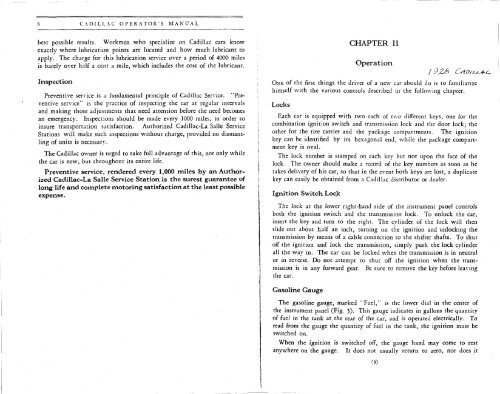1928 Cadillac - GM Heritage Center
1928 Cadillac - GM Heritage Center
1928 Cadillac - GM Heritage Center
You also want an ePaper? Increase the reach of your titles
YUMPU automatically turns print PDFs into web optimized ePapers that Google loves.
CADILLAC OPERATOR'S MANUAL<br />
best possible results. Workmen who specialize on <strong>Cadillac</strong> cars know<br />
exactly where lubrication points are located and how much lubricant to<br />
apply. The charge for this lubrication service over a period of 4000 miles<br />
is barely over half a cent a mile, which includes the cost of the lubricant.<br />
Inspection<br />
Preventive service is a fundamental principle of <strong>Cadillac</strong> Service. "Preventive<br />
service" is the practice of inspecting the car at regular intervals<br />
and making those adjustments that need attention before the need becomes<br />
an emergency. Inspections should be made every 1000 miles, in order to<br />
insure transportation satisfaction. Authorized <strong>Cadillac</strong>-La Salle Service<br />
Stations will make such inspections without charge, provided no dismantling<br />
of units is necessary.<br />
The <strong>Cadillac</strong> owner is urged to take full advantage of this, not only while<br />
the car is new, but throughout its entire life.<br />
Preventive service, rendered every 1,000 miles by an Authorized<br />
<strong>Cadillac</strong>-La Salle Service Station is the surest guarantee of<br />
long life and complete motoring satisfaction at the least possible<br />
expense.<br />
CHAPTER II<br />
Operation<br />
/ 9ZS C/iD/^t-Af-c<br />
ONE of the first things the driver of a new car should do is to familiarize<br />
himself with the various controls described in the following chapter.<br />
Locks<br />
Each car is equipped with two each of two different keys, one for the<br />
combination ignition switch and transmission lock and the door lock; the<br />
other for the tire carrier and the package compartments. The ignition<br />
key can be identified by its hexagonal end, while the package compartment<br />
key is oval.<br />
The lock number is stamped on each key but not upon the face of the<br />
lock. The owner should make a record of the key numbers as soon as he<br />
takes delivery of his car, so that in the event both keys are lost, a duplicate<br />
key can easily be obtained from a <strong>Cadillac</strong> distributor or dealer.<br />
Ignition Switch Lock<br />
The lock at the lower right-hand side of the instrument panel controls<br />
both the ignition switch and the transmission lock. To unlock the car,<br />
insert the key and turn to the right. The cylinder of the lock will then<br />
slide out about half an inch, turning on the ignition and unlocking the<br />
transmission by means of a cable connection to the shifter shafts. To shut<br />
off the ignition and lock the transmission, simply push the lock cylinder<br />
all the way in. The car can be locked when the transmission is in neutral<br />
or in reverse. Do not attempt to shut off the ignition when the transmission<br />
is in any forward gear. Be sure to remove the key before leaving<br />
the car.<br />
Gasoline Gauge<br />
The gasoline gauge, marked "Fuel," is the lower dial in the center of<br />
the instrument panel (Fig. 3). This gauge indicates in gallons the quantity<br />
of fuel in the tank at the rear of the car, and is operated electrically. To<br />
read from the gauge the quantity of fuel in the tank, the ignition must be<br />
switched on.<br />
When the ignition is switched off, the gauge hand may come to rest<br />
anywhere on the gauge. It does not usually return to zero, nor does it<br />
(9)
















